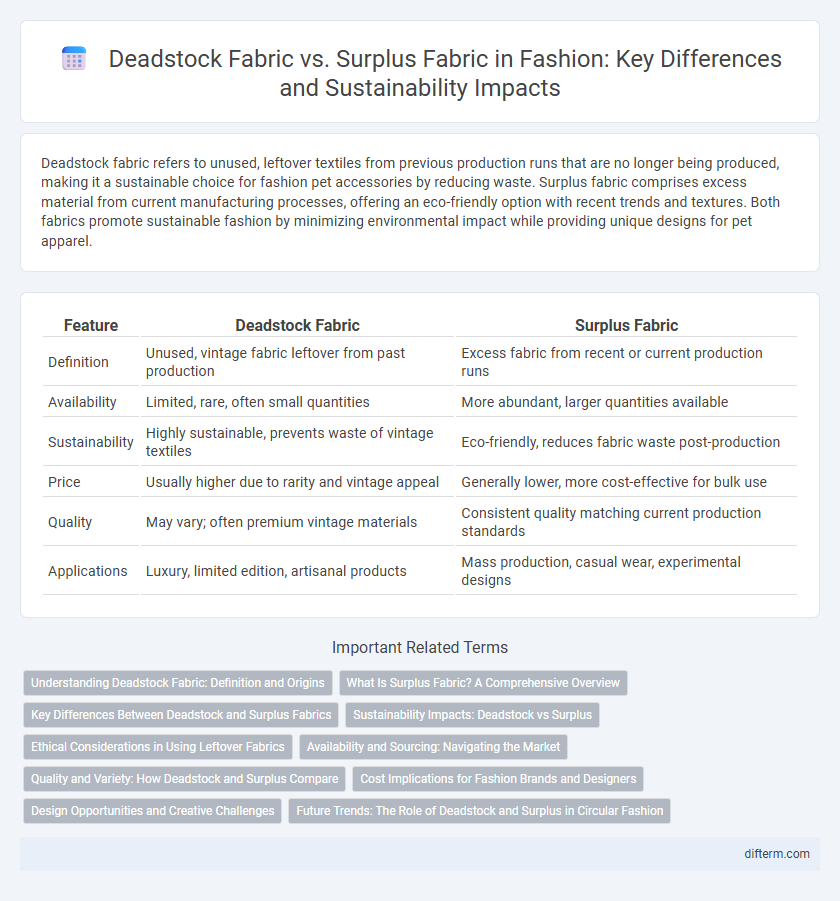Deadstock fabric refers to unused, leftover textiles from previous production runs that are no longer being produced, making it a sustainable choice for fashion pet accessories by reducing waste. Surplus fabric comprises excess material from current manufacturing processes, offering an eco-friendly option with recent trends and textures. Both fabrics promote sustainable fashion by minimizing environmental impact while providing unique designs for pet apparel.
Table of Comparison
| Feature | Deadstock Fabric | Surplus Fabric |
|---|---|---|
| Definition | Unused, vintage fabric leftover from past production | Excess fabric from recent or current production runs |
| Availability | Limited, rare, often small quantities | More abundant, larger quantities available |
| Sustainability | Highly sustainable, prevents waste of vintage textiles | Eco-friendly, reduces fabric waste post-production |
| Price | Usually higher due to rarity and vintage appeal | Generally lower, more cost-effective for bulk use |
| Quality | May vary; often premium vintage materials | Consistent quality matching current production standards |
| Applications | Luxury, limited edition, artisanal products | Mass production, casual wear, experimental designs |
Understanding Deadstock Fabric: Definition and Origins
Deadstock fabric refers to unused, leftover textile materials from previous fashion seasons, often sourced directly from fabric mills or manufacturers. These fabrics are typically of high quality and unavailable in current production, making them valuable for sustainable and unique fashion creations. Understanding deadstock fabric origins helps designers reduce waste by repurposing these scarce, pre-existing resources instead of relying on new fabric production.
What Is Surplus Fabric? A Comprehensive Overview
Surplus fabric refers to excess textile material that remains after the completion of production runs, often originating from over-ordered or unused fabric in fashion manufacturing. Unlike deadstock fabric, which typically consists of vintage or discontinued rolls, surplus fabric is newly produced but unsold or leftover inventory. This type of fabric offers sustainable opportunities for designers aiming to reduce waste while accessing high-quality materials at lower costs.
Key Differences Between Deadstock and Surplus Fabrics
Deadstock fabric refers to unused, leftover materials from previous manufacturing runs that are often vintage or discontinued, ensuring unique and limited-edition textile options for designers. Surplus fabric consists of excess inventory produced beyond demand or canceled orders, usually abundant and more readily available in various modern prints and textures. The key differences lie in their origin--the rarity and exclusivity of deadstock versus the volume and accessibility of surplus--impacting sustainability and design choices in fashion production.
Sustainability Impacts: Deadstock vs Surplus
Deadstock fabric, consisting of unused excess inventory from previous productions, minimizes waste by repurposing materials that would otherwise be discarded, enhancing sustainability in fashion. Surplus fabric, often leftover material from active manufacturing runs, can contribute to supply chain inefficiencies and increased landfill waste if not properly managed. Utilizing deadstock reduces the need for new textile production, lowering environmental impact through decreased water usage, chemical treatments, and carbon emissions compared to surplus fabric that may not be efficiently recycled.
Ethical Considerations in Using Leftover Fabrics
Deadstock fabric involves unused, leftover textile from previous production runs, ensuring zero waste creation and supporting sustainable fashion by reducing the need for new fabric production. Surplus fabric, often excess inventory from current manufacturers, can contribute to waste if not repurposed ethically, but when reused thoughtfully, it minimizes landfill contributions and resource depletion. Both fabrics promote ethical fashion by encouraging waste reduction and extending the lifecycle of existing materials, crucial for lowering environmental impact in the apparel industry.
Availability and Sourcing: Navigating the Market
Deadstock fabric refers to unused, leftover textile stock often sourced from past production runs or discontinued lines, offering limited availability tied to historical collections. Surplus fabric, by contrast, originates from excess current production and is typically more readily available in larger quantities, making it easier for contemporary sourcing. Navigating the market requires designers to evaluate deadstock for unique, rare materials and surplus fabric for consistent supply and cost efficiency.
Quality and Variety: How Deadstock and Surplus Compare
Deadstock fabric offers unmatched quality as it consists of unused, leftover materials from previous production runs, ensuring pristine condition and unique patterns often no longer available. Surplus fabric includes excess materials from ongoing or outdated stock, which may vary in quality but provides a broader range of fabric types and textures. Both deadstock and surplus fabrics contribute to sustainable fashion by reducing waste while catering to diverse design needs.
Cost Implications for Fashion Brands and Designers
Deadstock fabric offers fashion brands a cost-effective option by providing high-quality materials at significantly reduced prices due to excess inventory from past seasons. Surplus fabric, while also affordable, often comes from overproduction, sometimes leading to inconsistency in fabric quality and availability, impacting production budgets for designers. Choosing deadstock fabric can enhance sustainability efforts and control material costs, whereas surplus fabric requires careful sourcing to balance cost savings with product quality.
Design Opportunities and Creative Challenges
Deadstock fabric offers unique design opportunities by providing exclusive, limited-edition materials that inspire innovative, one-of-a-kind fashion pieces. Surplus fabric presents creative challenges through its variability and abundance, requiring designers to skillfully repurpose and combine materials to maintain cohesive collections. Both deadstock and surplus fabrics encourage sustainable practices, pushing designers to think resourcefully while expanding aesthetic possibilities.
Future Trends: The Role of Deadstock and Surplus in Circular Fashion
Deadstock fabric, consisting of unused, obsolete textile inventory, and surplus fabric, which refers to excess produced material, both play crucial roles in advancing circular fashion by minimizing waste and promoting resource efficiency. Emerging trends highlight increased industry adoption of these materials for upcycled collections, reducing environmental impact and supporting sustainable production cycles. Innovations in fabric sorting technology and digital marketplaces are accelerating the integration of deadstock and surplus textiles into mainstream fashion supply chains.
Deadstock Fabric vs Surplus Fabric Infographic

 difterm.com
difterm.com